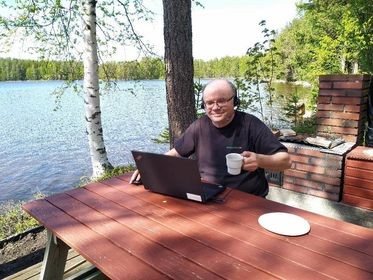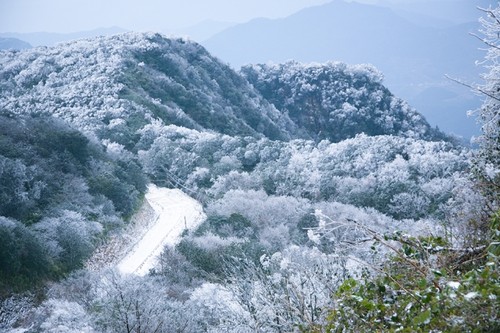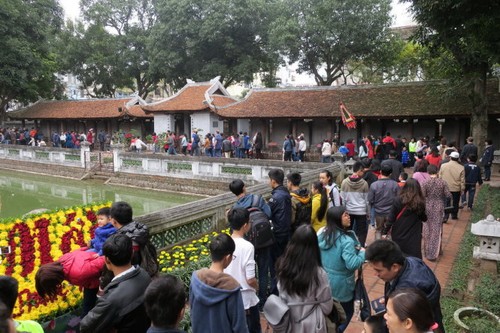 Jyrki Hytonen, a Finnish Dx'er Jyrki Hytonen, a Finnish Dx'er |
B: Jyrki Hytonen, a Finnish forest researcher, told us that he’s interested in nature and forests. He studies afforestation. Two years ago, before the COVID-19 pandemic outbreaks, he visited Vietnam for 2 weeks. In Ho Chi Minh City, Phan Thiet, and other places, he saw with his own eyes the rapid development of Vietnam.
A: Mr. Hytonen said: “I liked very much the Vietnamese food, hospitality, friendliness, climate, scenery, and culture. It was an eye-opening visit which made me want to come back to Vietnam. VOV is a good channel to learn what is going on in Vietnam and other parts of the world. I listen to Voice of Vietnam in English and visit your web page. I also listen online to some of your programs in Spanish because I want to keep my Spanish language skills and refresh them.”
B: Thank you, Hytonen for appreciating Vietnam and VOV. Until global travel returns to normal, we hope you’ll continue tuning in to VOV for information about Vietnam and the world. Last time you visited Vietnam’s southern region. Maybe next time you’ll visit central and northern Vietnam to study their diverse mountain and forest ecosystems.
 Phia Oac mountain in Cao Bang province Phia Oac mountain in Cao Bang province |
A: The diverse topography and the influence of the East Sea (internationally known as the South China Sea) creates climatic conditions that vary significantly between regions. Vietnam has 34 national parks that stretch from its northern border to its southern islands. They were set up to protect natural ecosystems, flora, fauna, and diverse natural landscapes.
B: We hope to welcome you to Vietnam very soon. Vietnam plans to gradually resume international travel later this year if vaccination and other pandemic measures continue to be effective.
A: From Sweden, Jan Edh emailed us to say: “On September 17th I listened to shortwave radio, hoping to hear some far away radio stations. I was lucky enough to hear a transmission from Voice of Vietnam on 740 kHz at 4:48 Vietnamese time.”
B: We listened to the short recording from the program you sent us. It was a local morning program that started with the Vietnamese National Anthem and the announcement of a morning physical exercise session.
A: It’s interesting to learn that you caught the signal at such a long distance. It wasn’t clear, but was audible. The morning workout is on air from 4:45 to 5:05 a.m on the VOV1, VOV2, and VOV3 channels. There are instructions for simple breathing exercises and up and down movements to begin a healthy, joyful day.
B: For more than 75 years, VOV’s morning signature tune has been a kind of alarm clock for millions of households, particularly in the past when VOV was the sole radio channel in Vietnam. The theme is stuck in the heads of people and recalls their memories of their grandparents and parents waking up very early in the morning, doing some morning exercise, listening to the radio news, and preparing to go to work.
A: Now there are countless sources of information but listening to VOV is still a habit for many Vietnamese people. They tune in to VOV’s multiple channels while doing morning exercises and driving to work.
 VOV's channels on mobile app VOV's channels on mobile app |
B: Jan Edh, a retired journalist, told us: “I worked 43 years for the local newspaper in Hudiksvall, 30 years as the managing editor. For a period I was also the publisher of the local gates in FM radio, Radio Rix, and I was one of the crew of local events radio station ‘Radio Dellen’ on 1602 kHz.”
A: We’re happy to hear from a radio professional. Jan said, “I’ve been a Dx’er since 1959. My listening shack is situated some 20 miles west of Hudiksvall and 200 miles north of Stockholm in the forest to be free of disturbances from the urban area. I listen on a computerized radio called an RF Space NetSDR. In the shack I have Beverage antennas running in nine directions and between 700 and 900 meters long. This reception was taken on an antenna directed towards South Asia which is 800 meters long.”
B: Thank you very much for sharing with us details about your hobby and your radio room. We’ll send you VOV’s frequency list for our winter broadcasts so you can keep tuning in to our programming.
A: Shivendu Paul of India told us that he tuned in to many of VOV’s English programs in October and received good reception at 16:00-16:30 UTC on 7220 khz on a Grundig YB 80 receiver in West Bengal, India.
B: But on October 18, he couldn’t catch any program for unknown reasons. He wants feedback from other listeners. Did you have any problems picking up VOV’s shortwave broadcast on that day?
A: We haven’t received any feedback from other listeners about similar problems. If we’ll get any new information, we’ll let you know.
B: Shivendu Paul told us that postal service has returned to normal in India, and asked, “How is post service in Vietnam now?”
A: Vietnam has resumed postal service to certain countries, so we’ll send QSL cards and other materials to listeners by post mail again.
 On New Year celebration, poeple visit the Temple of Literature to pray for good luck at examinations. On New Year celebration, poeple visit the Temple of Literature to pray for good luck at examinations. |
B: Siddhartha Bhattacharjee of India said he has heard about the Temple of Literature in Hanoi, and wants to learn more about it and its importance.
A: The Temple of Literature is one of Hanoi’s most famous tourist attractions. Built in 1070 as a university dedicated to Confucius, scholars, and sages, the original building is extremely well preserved and is a superb example of traditional Vietnamese architecture.
B: This ancient site comprises a Lake of Literature, a Well of Heavenly Clarity, turtle steles, pavilions, courtyards, and walk ways that were once used by royalty. Initially the university only accepted aristocrats, the elite, and royal family members as students, before eventually opening its doors to excellent ‘commoners’. Successful graduates had their names engraved on stone steles planted on top of stone turtles.
A: The Temple is now a memorial to education and literature. It is a place of study rather than a religious landmark. The Temple of Literature's 82 steles engraved with the names of doctorate holders dating as far back as 1442 have been recognized as a World Documentary Heritage Site by UNESCO.
B: The steles record, engraved in old Chinese characters, 82 royal examinations held between 1442 and 1779 during the Le and Mac dynasties. The stone stand on the backs of stone tortoises, who symbolize longevity and permanence.
A: The doctoral steles were Vietnam's second documentary heritage recognized by UNESCO's Memory of the World program.
B: Ratan Kumar Paul of India asks: “How many Vietnamese have received a Noble Prize?”
A: The only man in history to ever turn down the Nobel Peace Prize was Vietnamese revolutionary, diplomat, and politician Le Duc Tho. For his role as Vietnam's chief negotiator in the Paris Peace Accords, in 1973 he was jointly awarded the prize alongside his American counterpart, Henry Kissinger.
B: Le Duc Tho rejected the Nobel Peace Prize, saying, “Peace has not yet really been established in South Vietnam. In these circumstances, it is impossible for me to accept.”
A: He added, “I will be able to consider acceptance only when the Paris Accord is respected, the arms are silenced, and real peace is established in South Vietnam.”
B: His decision and explanation were disclosed in a letter to the President of the Norwegian Parliament's Nobel Prize Committee.
A: Thank you all for your feedback. We always welcome your letters at English Service, VOVWorld, the Voice of Vietnam, 45 Ba Trieu street, Hanoi, Vietnam. Or you can email us at: englishsection@vov.vn.
A: You can also leave your comments on our website at www.vovworld.vn or on our Facebook fanpage at VOV5 English Service. Thank you all. Stay safe and healthy. Goodbye!